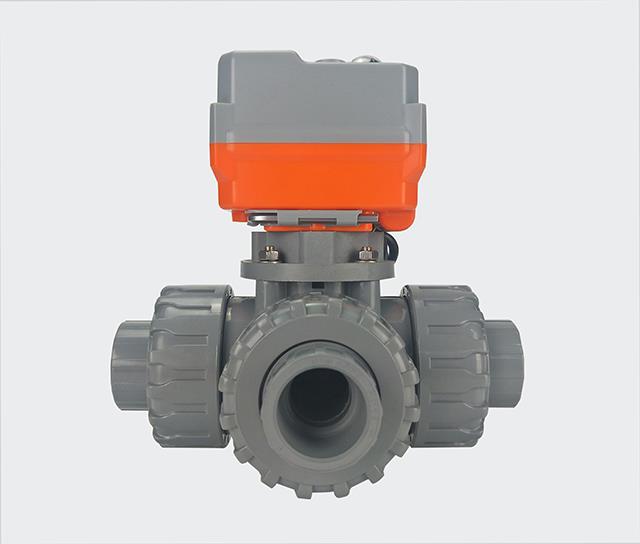Understanding the differences between UPVC, CPVC, and PVDF ball valves is essential for anyone working with fluid control systems. These types of plastic valves each offer unique properties tailored to specific industrial needs. UPVC ball valves are lightweight, cost-effective, and resistant to corrosion, making them ideal for applications like water distribution. CPVC ball valves, on the other hand, excel in handling higher temperatures and are often used in chemical processing and hot water systems. PVDF ball valves stand out for their exceptional chemical resistance and durability. Making them the preferred choice for demanding industries such as pharmaceuticals and chemical manufacturing. By comparing their material strengths, temperature and pressure tolerances, and cost-effectiveness, readers gain clarity on which plastic ball valve to select for their systems. Choosing the right valve, whether it’s a PVC ball valve or a CPVC ball valve, ensures safety, efficiency, and compliance across various applications.
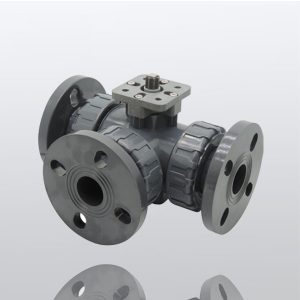
Introduction
The adoption of plastic valves in industrial fluid control systems has seen remarkable growth in recent years, driven by their distinct advantages over traditional metal valves. Materials like UPVC, CPVC, and PVDF offer exceptional resistance to corrosion. Allowing them to withstand exposure to aggressive chemicals and harsh environments without degrading. Their lightweight design not only simplifies installation but also reduces overall system stress. Making them a practical choice for various applications.
Plastic valves are also more cost-effective, offering long-term performance without the need for extensive maintenance or replacement. Which can be common with metallic alternatives in corrosive settings. Their versatility enables use across diverse industries. Including water treatment, chemical processing, pharmaceutical manufacturing, and more. By efficiently balancing performance, affordability, and durability, plastic valve are transforming the way industries handle fluid control. Cementing their position as a preferred solution in a broad range of applications.
Plastic ball valves, widely recognized for their versatility and reliability, are commonly manufactured from three main materials: UPVC, CPVC, and PVDF, each offering distinct properties tailored to specific industrial needs.
UPVC (unplasticized polyvinyl chloride) valves are celebrated for their affordability, lightweight design, and robust resistance to corrosion. Making them an ideal choice for water distribution, irrigation, and low-temperature fluid systems.
CPVC (chlorinated polyvinyl chloride) ball valve, on the other hand, exhibit enhanced thermal capabilities, allowing them to handle higher temperatures and making them suitable for hot water systems, chemical processing, and industrial piping involving mildly aggressive substances.
Meanwhile, PVDF (polyvinylidene fluoride) ball valves stand out as the premium option, renowned for their exceptional chemical resistance, high durability, and performance under extreme conditions. These qualities make PVDF valves the preferred solution in highly corrosive or high-pressure environments. Such as chemical manufacturing, pharmaceuticals, and semiconductor processing. Together, these three types of plastic ball valves provide industries across the spectrum with precise fluid control solutions that balance performance, cost-effectiveness, and material-specific strengths.
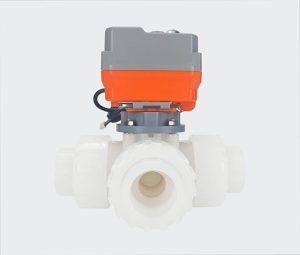
1. What is a UPVC Ball Valve?
UPVC, or unplasticized polyvinyl chloride, is a highly durable and versatile thermoplastic material widely used in various industrial applications due to its exceptional properties. Unlike traditional PVC, UPVC does not contain plasticizers. Which gives it a rigid structure and enhances its strength and longevity. One of its key characteristics is its remarkable resistance to corrosion, chemicals, and UV exposure. Making it particularly suited for environments exposed to harsh substances or prolonged sunlight.
UPVC also boasts excellent thermal and acoustic insulation properties. Which contribute to its efficiency and practicality in construction and fluid control systems. Its lightweight nature simplifies installation and reduces transportation costs. While its affordability makes it a cost-effective alternative to metals or other more expensive materials. UPVC’s strong, non-reactive nature has made it the preferred material for producing pipes, fittings, valves, and other components in water distribution, irrigation, and low-pressure fluid transfer systems. Additionally, its low-maintenance and eco-friendly profile further solidify its position as a pragmatic and sustainable choice in a wide range of industrial and residential applications.
2. What is a CPVC Ball Valve?
CPVC, or chlorinated polyvinyl chloride, is a thermoplastic material known for its enhanced thermal resistance and chemical durability, distinguishing it from UPVC (unplasticized polyvinyl chloride). The chlorination process in CPVC alters its molecular structure. Allowing it to withstand much higher temperatures compared to UPVC. Which makes it particularly suitable for industries dealing with hot or aggressive fluids. Additionally, CPVC demonstrates superior resistance to a wide range of chemicals, including acids, bases, and salts, further expanding its versatility in harsh industrial environments.
This makes it a preferred choice in applications such as hot water distribution, chemical processing, and power generation, where UPVC’s lower temperature tolerance may be limiting. CPVC also exhibits excellent mechanical strength and retains its structural integrity under high-pressure conditions, contributing to its reliability in demanding systems. While UPVC is favored for its cost-effectiveness in less aggressive environments, CPVC is the material of choice when both temperature and chemical resistance are critical. Providing a specialized solution for high-performance fluid control needs.
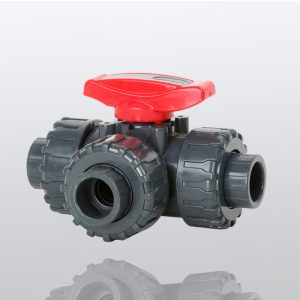
3. What is a PVDF Ball Valve?
PVDF, or polyvinylidene fluoride, is a high-performance thermoplastic material renowned for its exceptional chemical resistance, durability, and ability to withstand extreme conditions. Its molecular structure lends it superior resistance to a wide array of corrosive chemicals. Including strong acids, halogens, and organic solvents, making it an optimal choice for highly aggressive environments. PVDF also excels in high-temperature applications, maintaining its mechanical and structural integrity even under continuous exposure to extreme heat. While its impressive resistance to high pressures further enhances its reliability in demanding fluid control systems.
These features make PVDF a premium material, particularly valued in industries. Such as chemical manufacturing, pharmaceuticals, power generation, and semiconductor processing. Where equipment must endure harsh operating conditions while ensuring operational safety and precision. Additionally, PVDF is inherently UV-resistant and exhibits excellent aging characteristics, allowing it to perform reliably over long periods, even in outdoor or exposed environments. Though it is a higher-cost material compared to UPVC and CPVC, PVDF’s unparalleled performance and long-term durability justify its use in critical applications that demand maximum efficiency and resilience.
4. Key Differences Between UPVC, CPVC, and PVDF Ball Valves
UPVC, CPVC, and PVDF ball valves each bring unique advantages to industrial fluid control but differ significantly across key factors such as material properties, applications, durability, and cost-effectiveness.
UPVC is valued for its rigid structure, excellent chemical resistance, and cost-efficiency. Making it an ideal choice for low-temperature and less aggressive applications such as water distribution, irrigation, and wastewater systems. However, UPVC is less suited for environments requiring resistance to extreme temperatures or UV exposure. Which can limit its longevity in outdoor or high-heat conditions.
CPVC, through its chlorinated composition, provides enhanced thermal resistance compared to UPVC. Allowing it to perform reliably in hot water systems, chemical processing, and industrial applications that require exposure to higher temperatures. Its chemical resistance is similarly robust, though it comes at a slightly higher cost.

PVDF, as a premier material, outshines both UPVC and CPVC in resistance to extreme temperatures, harsh chemicals, UV, and high-pressure conditions. Ensuring unmatched performance and longevity in the most demanding environments, such as chemical manufacturing and semiconductor processes.
However, PVDF’s superior performance is reflected in its higher upfront cost, often outweighing UPVC and CPVC in terms of total ownership expense for standard applications. Ultimately, UPVC provides cost-effective solutions for basic systems, CPVC bridges the gap for moderate thermal demands. And PVDF offers an unparalleled choice where maximum durability and operational safety under severe conditions are paramount. Selecting the appropriate material requires balancing application requirements against cost to ensure optimal performance and long-term value.
5. How to Choose the Right Plastic Ball Valve for Your System
Selecting the most suitable ball valve for your specific application requires careful consideration of several critical factors to ensure optimal performance and longevity. Start by evaluating the type of fluid being handle; corrosive or chemically aggressive substances demand materials like CPVC or PVDF for their superior chemical resistance. While UPVC may suffice for neutral or less reactive fluids. Operating temperature and pressure are equally crucial; for high-temperature systems or pressurized environments, prioritize materials like CPVC or PVDF that can withstand these conditions without compromising structural integrity.
Additionally, consider chemical compatibility by matching the valve’s material to the specific chemicals in use. As this will prevent degradation or failure over time. Environmental conditions, such as exposure to UV rays, moisture, or outdoor elements, also play a role; for prolonged outdoor use, PVDF’s exceptional UV resistance and durability make it an excellent choice. Lastly, budget constraints must be balanced against application demands. While UPVC offers cost-effective solutions for general-purpose systems, CPVC and PVDF provide increased performance at a higher initial investment. Carefully assessing these factors and consulting with industry experts ensures you select a ball valve that meets your operational needs and delivers long-term value.
FAQs
1. What industries typically use CPVC Ball Valve?
CPVC Ball Valves are widely used across industries that handle aggressive chemicals, such as:
Chemical processing plants
Water treatment facilities
Pharma and biotech industries
Mining and metallurgy
Food and beverage production (where high chemical resistance is required)
2. What are the primary maintenance requirements for CPVC Ball Valve?
To maintain optimal performance, routine checks should include:
Inspecting for wear or damage on the ball, seat, and seals.
Ensuring the valve handle operates smoothly.
Checking for leaks around connection points.
If any components show significant wear or degradation, replace them according to the manufacturer’s recommendations.
3. What certifications do CPVC Ball Valves comply with?
CPVC Ball Valve often meet industry-specific certifications such as ISO, FDA, NSF, or RoHS compliance, depending on the manufacturer. Check with your supplier for detailed certification documentation for traceability and quality verification.
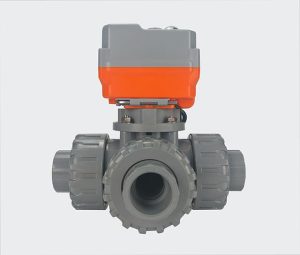
4. Where can I purchase CPVC Manual Ball Valves?
You can source CPVC Manual Ball Valves directly through certified valve distributors or manufacturers with a strong reputation for quality control and global reach. Ensure your supplier meets industry standards and provides the necessary technical support for your application needs.For further technical assistance or to request a quote, feel free to contact us. We’re here to ensure your operations run smoothly and safely!
Conclusion
When comparing UPVC, CPVC, and PVDF ball valves, it’s clear that each material offers distinct advantages tailored to specific operational requirements. UPVC valves stand out for their affordability and excellent resistance to various chemicals. Making them an ideal choice for general-purpose applications such as water distribution and wastewater management.
However, their limitations in handling high temperatures and prolonged UV exposure make them less suitable for demanding or outdoor environments. CPVC valves, on the other hand, provide a critical upgrade with enhanced thermal resistance and reliable chemical durability, positioning them as a versatile solution for moderate industrial processes. Including hot water and chemical handling systems.
Lastly, PVDF valves represent the pinnacle of performance, excelling in scenarios that demand superior resistance to extreme temperatures, highly corrosive chemicals, UV exposure, and high pressures. Industries such as chemical manufacturing and semiconductor processing often rely on PVDF for its unmatched durability. Even though it involves a higher initial cost.
Ultimately, selecting the right valve material involves balancing critical factors such as operating conditions, fluid characteristics, environmental exposure, and budget constraints. By understanding the unique properties and performance profiles of UPVC, CPVC, and PVDF, decision-makers can align their choices with the specific needs of their system. Ensuring optimal functionality, safety, and long-term value.

